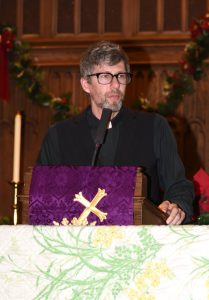Therefore not single persons, as formerly, but entire families are now in exile because of their confession of the Word. It is a crime not to help these. – Martin Luther, Lectures on Genesis (Chapter 18)

Martin Luther’s Lectures on Genesis contain some of his most compelling teachings about who the church is called to be in the world. Reflecting on the story of Abraham, Luther stakes out his claim that the church is called to be an agent of hospitality in an often inhospitable world. It’s an account worth reflecting on today, as we commemorate with others around the globe World Refugee Day.
An “Unparalleled” Example
Luther’s teachings on hospitality come in his lecture on the 18th chapter of Genesis, which tells the story of Abraham playing host to three visitors. As he is cooling off in the heat of the day, Abraham sees three men approaching. Immediately,
“he ran from the tent entrance to meet them and bowed down to the ground. He said, ‘My lord, if I find favor with you, do not pass by your servant. Let a little water be brought, and wash your feet, and rest yourselves under the tree. Let me bring a little bread, that you may refresh yourselves, and after that you may pass on—since you have come to your servant.’ So they said, ‘Do as you have said.’ And Abraham hastened into the tent to Sarah, and said, ‘Make ready quickly three measures of choice flour, knead it, and make cakes.’ Abraham ran to the herd, and took a calf, tender and good, and gave it to the servant, who hastened to prepare it. Then he took curds and milk and the calf that he had prepared and set it before them; and he stood by them under the tree while they ate” (Genesis 18:2b-8).
Abraham’s hospitality to the strangers is an “unparalleled” example of hospitality for Luther, according to Leopoldo A. Sánchez M. Yet, unique as it is, for Luther, Abraham’s example is one the church is called to follow.
Luther begins by noting especially Abraham’s earnest service of the strangers and his “generous and bounteous” attention to their needs. For Luther, this arises, in part, from Abraham’s own experience as an exile, a wanderer without a stable land. Equally important, though, for Luther, this virtue of hospitality is a basic teaching Abraham takes from the “patriarchs and from the practice of the church” (which Luther extends to include the religious heritage of Abraham.) This is so basic a practice to the church as church that Luther writes,
“At all times the church has been like some refuge of the exiles and the poor.”
There is a link between Abraham’s hospitality and the reference to hospitality in the book of Hebrews, according to Luther. There, readers are reminded, “Do not neglect to show hospitality to strangers, for by doing that some have entertained angels without knowing it” (Hebrews 13:2).
This is certainly nothing new. Hospitality is one of the most basic ethical practices of the people of God throughout scripture. In fact, Ezekiel points to inhospitality as the sin that brought down Sodom: “This was the guilt of your sister Sodom: she and her daughters had pride, excess of food, and prosperous ease, but did not aid the poor and needy” (Ezekiel 16:49), a verse Luther cites in his lecture here.
Hospitable Treatment of “All Guests”
Luther’s interpretation of Abraham makes clear that hospitality is primarily extended properly to other people of faith, people in the “in-group” of one’s neighbors or what Luther calls “exiles..because of their confession of the word.” Here, he means Christians forced to leave their homelands because of religious persecution. Had the visitors to Abraham not been among these, Abraham would have cared for them “but he would not have fallen down to the earth in accordance with brotherly love. For he knows that God dwells in the brethren and fellow believers, who are true temples of God, and not in the enemies of the faith or in those who have no knowledge of the true religion.”
That said, there is no reason to limit hospitality only to fellow believers, or to draw firm lines between who is worthy of “refuge” and who isn’t. “Even if they had been enemies,” Luther writes, Abraham “would not have let them go but would have refreshed them first in accordance with love.” He goes on to say:
“I am not displeased with the opinion of those who say that Abraham learned from instances that had happened both to him and to his ancestors, and that he experienced rather often that angels, coming in the form of human beings, enjoyed the hospitality of human beings, as we shall hear later about Lot in Sodom (Gen. 19:1 ff.). Because of this experience they treated all guests rather respectfully and hoped for occasions on which they themselves would associate with angels.”
For a theologian who was well-known for his displeasure, even this modest allowance is worth noting.
More pointedly, Luther goes on to say:
“Indeed, we should be generous not only toward the brethren and such as are exiled because of their confession but also toward those who are strangers in the state, provided that they are not manifestly evil…Even though he is not suffering because of the Word but is in distress in other respects, he should not be disregarded by us.”
Interestingly, Luther seems also to enjoin public officials and other citizens beyond the church to extend this same sort of protection and assistance, praising Elector John Frederick’s approach to exiles:
“By God’s grace the wretched exiles now have a place under our most illustrious Prince. Here they can flee for refuge, and here they are safe. But I am afraid that someone else will come—someone who does not know Joseph (Ex. 1:8); and I fear that this will happen because of the excessive cruelty, inhospitality, and greed of human beings. The nobles, the burghers, and the peasants do not help the churches with a single obol to be able to be generous toward exiles.”
Without reading too much into this, it appears that Luther believes that hospitality is not private Christian charity but a public virtue for the community and state, inasmuch as the latter creates the opportunity for the church to be of service.
A Realistic Assessment
Luther isn’t idealistic, though. He knows that there are those “exiles” who may take advantage of hospitality for their own greedy or malicious purposes. But here, we have to remember that Luther is not a consequentialist; the morality of an action is in its practice, not in the good or bad consequence that it brings about. Hospitality is a virtue, a good in itself. Drawing on Jesus’ willingness to heal the ten lepers, despite knowing that most would not show him gratitude, Luther commends the practice of hospitality in spite of the risks:
“If we are deceived now and then, well and good. In spite of this our good will is demonstrated to God, and the kind act which is lost on an evil and ungrateful person is not lost on Christ, in whose name we are generous. Hence just as we should not intentionally and knowingly support the idleness of slothful people, so, when we have been deceived, we should not give up this eagerness to do good to others.”
Why should the church practice hospitality? Not because every stranger is an “angel” in disguise, but because that is what the church does in the name of Christ.
At a time when more than 68 million people around the world are either refugees or internally displaced because of violence or persecution, Luther’s call to practice earnest hospitality is as important as ever. While we can’t risk drawing too simple of a line between his time and ours, we also can’t risk losing sight of a virtue so central to what makes us church.
This is one of the reasons ELCA World Hunger continues to support projects that accompany refugees, migrants, and others on the move. The practice of hospitality is not merely a command that Lutherans are called to follow but rather, as Luther himself highlights, part of heritage as people of faith and as exiles ourselves. And who knows, maybe by so doing, we will entertain angels. But even if we don’t, we can still take comfort in the fact that the church will be what it is called to be: “like some refuge of the exiles and the poor.”
For more on Lutherans and refugees, see this earlier post.
To support refugees and other neighbors seeking refuge in the United States, join the efforts of ELCA Advocacy through this important advocacy action in honor of World Refugee Day.
Ryan P. Cumming, Ph.D., is the program director of hunger education for ELCA World Hunger.
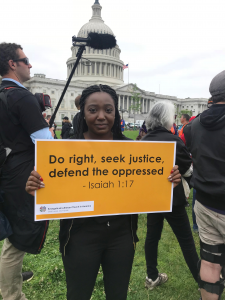 ristians, we are taught to have faith in each and every situation. Situations that are good, situations that could possibly go wrong, and even situations that will go wrong. It seems like such an easy principle to follow until you’re civically engaged. Faith-based advocacy requires you to keep the faith no matter the current policy issues and/or legislation are.
ristians, we are taught to have faith in each and every situation. Situations that are good, situations that could possibly go wrong, and even situations that will go wrong. It seems like such an easy principle to follow until you’re civically engaged. Faith-based advocacy requires you to keep the faith no matter the current policy issues and/or legislation are.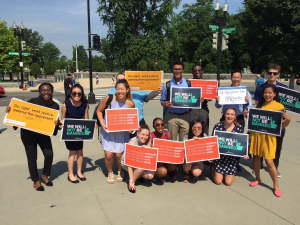


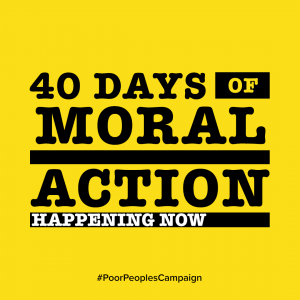




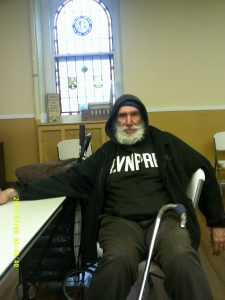

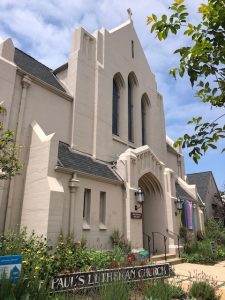
 We start with an abbreviated/streamlined gathering rite at the font, which at St. Paul’s is located in the very heart and center of the sanctuary. For us, this summer rite is often a brief seasonal Kyrie-infused confession found in a resource called Prayers for an Inclusive Church, by Steven Shakespeare (Church Publishing, New York, 2009). Occasionally, albeit rarely, we have gathered simply with a hymn, followed by the greeting and prayer of the day. One could also consider using a responsive reading of the day’s psalm here as well, letting the service flow quickly to the “Word” section.
We start with an abbreviated/streamlined gathering rite at the font, which at St. Paul’s is located in the very heart and center of the sanctuary. For us, this summer rite is often a brief seasonal Kyrie-infused confession found in a resource called Prayers for an Inclusive Church, by Steven Shakespeare (Church Publishing, New York, 2009). Occasionally, albeit rarely, we have gathered simply with a hymn, followed by the greeting and prayer of the day. One could also consider using a responsive reading of the day’s psalm here as well, letting the service flow quickly to the “Word” section.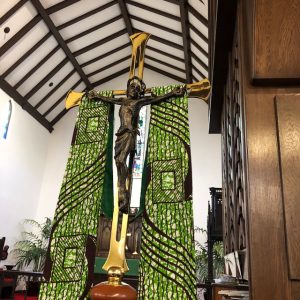
 Fabric squares for Ordinary Time by Jeanette Paulson, Adorn This House, Duluth MN
Fabric squares for Ordinary Time by Jeanette Paulson, Adorn This House, Duluth MN


